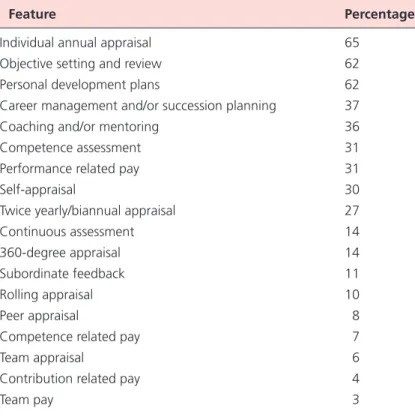No part of this publication may be reproduced, stored in a retrieval system, or transmitted in any form or by any means, electronic, mechanical, photocopying, recording, or otherwise, without the prior written permission of the publisher. Bodmin, Cornwall For information on all Butterworth-Heinemann publications visit our website at http://books.elsevier.com.
List of tables
List of abbreviations
Preface
A further aspect of context is the need to understand the dynamic and changing environment in which tourism and hospitality organizations operate. As already mentioned, this book is the culmination of many years of interest in the field of tourism and hospitality, both as a teacher and researcher.
Human resource
Chapter objectives
Introduction
This book attempts to address some of the key human resource (HR) issues that must be addressed in order for organizations to maintain such an environment. To do this it will take a critical look at some of the issues that have led many to characterize tourism and hospitality as generally unrewarding and unattractive, while also considering examples of good practice, key policy responses and models of HRM which can lead to more optimism. in the way people are managed in the tourism and hospitality industry.
What are the tourism and hospitality industries?
Given the diversity of both the range of sub-sectors and the types of jobs they are likely to generate, this book cannot cover all of these aspects in detail. Ultimately, the main purpose of the book is to try to understand the potentially diverse work experience of those who work in what we will broadly think of as the tourism and hospitality industry.
Who makes up the tourism and hospitality workforce? A brief snapshot
The number of ethnic minority workers in the wider hospitality, leisure, travel and tourism sector is 11 per cent, slightly higher than the figure for all industries of 9.6 per cent (People 1st, 2006). In terms of qualifications, only 12 per cent of employees in hospitality, leisure, travel and tourism have a degree or equivalent compared to a figure for all industries of 29 per cent, with 15 per cent of the workforce having no qualification compared to 11 percent of the total workforce (People 1st, 2006).
What is HRM?
After a brief consideration of the nature of the hospitality and tourism industry and the characteristics of its workforce, attention now turns to understanding HRM and the increasingly important role it is felt to play in organizational success.
Review and reflect
A hologram captures much of the discussion above in recognizing the fluid identity of HRM and the fact that it has multiple meanings. As well as providing the concise definition used above, Storey (1987) also provided one of the earliest and most enduring attempts to recognize different approaches to HRM.
HRM in practice 1.1 Hard and soft approaches to HRM in the airline industry
This support for the importance of HRM practices that 'fit' the organizations own strategically defined market segment to create a fit between the functional areas of marketing, operations and HRM is also seen in the work of Lashley and Taylor (1998) . Usually in terms of 'bundles', the HRM practices offered in support of a high commitment.
Models or reality?
In these circumstances, models that allow for the recognition of different strategic intent in HRM are still useful in enabling us to appreciate why and how companies differ in their approaches to HRM in tourism and hospitality. It would be naive to think that we can talk about HRM in hospitality tourism in very broad terms.
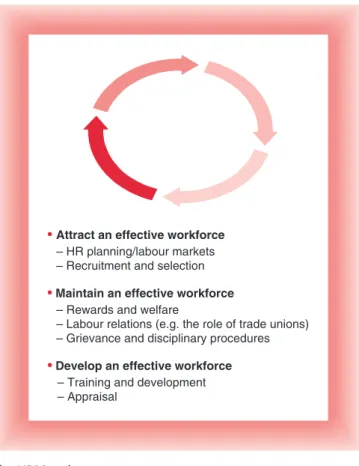
The bad news … pessimistic views of HRM in tourism and hospitality
Another reason for continued pessimism is the general attitude of employers and, in particular, the degree to which they are willing to acknowledge the extent of the HRM problem in the sector. In summary, a number of reasons can explain poor HR practices in the tourism and hospitality industry.
The good news … best practice in tourism and hospitality
To be fair, Hoque's exclusive reliance on managerial voices is not unique and is shared by much of the literature on HRM. The main point that emerges from the work of people like Redman and Matthews and Hoque is what good HRM practice is likely to look like in the tourism and hospitality industry.
Where this book stands
HRM in practice 1.2 The HRM quality enhancer hotel
As we have already noted, tourism and hospitality are likely to offer great diversity in terms of HRM policies and practices and it would be nice to think that these are rarely bad or stupid. In short, although all tourism and hospitality employers are unlikely to aspire to the luxury version of best practice for various reasons, they should at least aim to avoid the real howlers as suggested by Boxall and Purcell.
Conclusion
With this perspective in mind, this book aims to develop a realistic account of how tourism and hospitality employers develop and implement their HRM policies and practices and what this will mean for employees. Ultimately, however, we need to be careful not to overgeneralize the nature of HRM in tourism and hospitality, so it is necessary to examine different practices and try to understand why these differences may exist.
1987) "Linking Competitive Strategy to Human Resource Management", The Academy of Management Executive Emotional and aesthetic labor: cost minimization and the work process in the Asia Pacific Airline Industry", Employee Relations. Storey (ed.) Human Resource Management: A Critical Text, Routledge Working in Hotels and Catering, International Thomson Press, 2nd Edition.
Websites
2000) 'Best practice' human resource management: perfect opportunity or dangerous illusion?', International Journal of Human Resource Management Skills, Organizational Performance and Economic Activity in the Hospitality Industry: A Literature Review, Universities of Oxford and Warwick: SCOPE. 2000) 'Economic determinism and human resource management practice in the hospitality and tourism industry', Tourism and Hospitality Research. 1987) 'Developments in human resource management: an interim report', Warwick Papers in Industrial Relations, 17, IRRU.
International human resource management
As a result, the modern tourism and hospitality industry is increasingly global, and this is important in several ways. As more and more multinational tourism and hospitality companies now sell their products outside their home countries, they face a number of problems in how to approach a range of HRM issues.
The emergence of IHRM
Consequently, the MNC with an ethnocentric orientation believes in the superiority of the home country way of doing things and this informs their strategies for staffing and managing overseas units. In a hierarchy, the geocentric strategy would be best because it incorporates both theoretical ideals.
HRM in practice 2.1 Orientations in the global hotel industry
What are some of the key skills needed to be a successful expatriate manager in the international tourism and hospitality industry? For example, industrial relations practices are more likely to resemble local environmental practices.
HRM in practice 2.2 American dominance of global economy and the international
In contrast to collectivist cultures there is likely to be a greater preference for working with others or in groups. Therefore, there is likely to be tension between the activities carried out by an MNC and the national system of employee/industrial relations in any host country.
MNCs and HRM policies and practices in the tourism and hospitality industry
1997) 'Development of international managers in the hospitality industry', International Journal of Contemporary Hospitality Management An examination of the organizational and cross-cultural challenges facing international hotel managers in Russia', International Journal of Contemporary Hospitality Management. International Human Resource Management, London: Sage The torturous evolution of the multinational corporation', Columbia Journal of World Business Towards an understanding of centricity: profiling international hotel group', in N.
Organizational culture
However, while many organizations and managers within the tourism and hospitality industry now see the management of organizational culture as a potential source of competitive advantage, there are others who caution against overly optimistic claims made about organizational culture. Recognizing these competing views on organizational culture, this chapter will aim to provide a balanced assessment of the place of organizational culture within a wider human resource strategy.
In search of a definition
On the other hand, the use of the term organizational culture reflects the way in which culture emerges from the social interaction between members of an organization; something that the organization is. Acknowledging the potentially contentious nature of organizational culture is important because it points to the way in which there can be a divergence between the rhetoric and the reality of organizational culture.
Competing views on organizational culture
HRM in practice 3.1 Strong culture at the Regent Hotel
A second point of criticism is the unitary assumptions that underpin the optimists' position on culture. More and more scholars and writers are seeking a middle ground between optimists and pessimists and this has led to the emergence of a realist research agenda.
HRM in practice 3.2 Culture as an Orwellian mechanism
Thus, and perhaps in response to the excellence genre, much of the research and theory from the 1980s onwards has often questioned the extent to which organizations can manage culture successfully. For example, Ogbonna and Harris note how culture change is more likely to occur during organizational formation, periods of crisis, or during leadership change.
How can we study organizational culture?
As Lashley and Lee-Ross note, 'The degree to which members hold these core values and norms as unquestionable determines whether the organizational culture is "strong" or. Such work is described as 'doing work by both management and employees as akin to a theatrical performance, where the workplace is perceived as similar to a stage' (p. 103).
HRM in practice 3.3 The use of language in Disney
Corporate stories will often focus on illustrating the core values in the organization, often by resorting to the achievements and daring actions of cultural heroes such as the founder of the organization. Indeed, Bearden (2001) notes that in the immediate aftermath of 9/11, each of Southwest's 32,000 employees agreed to return part of their wages to ensure the company's stability in a turbulent business environment (and see also HRM in Practice 3.5). .
HRM in practice 3.4 Warm fuzzies and cold pricklies: the use of metaphor in Pizza Hut
Sunoo (1995) suggests that this strategy of hiring the best people, treating them with respect and giving them the freedom to make decisions and have fun just being themselves has created some of the most loyal employees in the airline industry. Many tourism and hospitality organizations may realize that trying to connect with their employees to generate a more fundamental level of commitment to the right values, beliefs and attitudes or even basic assumptions in the organization may be doomed to failure. .
HRM in practice 3.5 Stories and myths from some of the great hospitality entrepreneurs
In this regard, it is assumed that employees are embedded in a strong organizational culture and consequently demonstrate a high level of commitment to the organization and its values. For example, much earlier work on culture, as exemplified by Peters and Waterman (1982), has often been supported by support for the strong culture thesis.
HRM in practice 3.6 A failure to adapt?
Ultimately, when considering the relationship between culture and performance, Alvesson notes that 'the relatively few systematic studies of the relationship between culture and performance lead us to conclude that none of these four ideas has received much empirical support'. As they suggest, 'the tenuous link between cultures, expertise and performance turned out to be very fragile.
Organizational culture and HRM: a reprise
That said, there is a need to consider some of the potential contradictions and dilemmas in managing culture. Some of the contradictions and dilemmas may well be due to the sectoral context in which an organization operates.
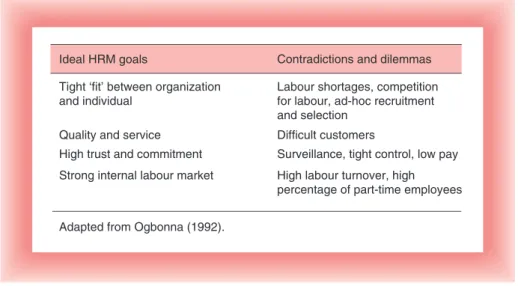
Labour markets
The falling birthrate means that by 2011 under-16s will make up just 18 per cent of the UK population. Longer life expectancy and more young people entering higher education means the workforce is 'greying' - the elderly make up the largest group in the workplace.
Levels of analysis in the labour market
We start with an understanding of the external labor market; that is the labor market outside the organization and consider in the first place the idea of a transnational labor market. In a more contemporary vein, one of the main drivers of an increasingly transnational and international job market is the role of multinational corporations (MNCs).
HRM in practice 4.1 EU expansion: A solution to labour and skill shortages in tourism and
For example, it is often argued that there is a clear difference between a European approach to labor markets, often described as the European social model; and the so-called Anglo-Saxon approach, which is represented by the US and to some extent the UK. In simple terms, it is suggested that the European social model tends to be much more regulatory.
To understand why this is the case, it is worth briefly considering recent developments in the UK labor market in the context of the above discussion. While all these aspects certainly added some regulation to the labor market and in fact influenced the HR policies of tourism and hospitality employers.
HRM in practice 4.2 Female friendly?
Finally, the scheme for part-time employees obliges employers to treat them no less favorably than full-time employees. As we noted in Chapter 1, hospitality and tourism are particularly dependent on part-time workers and it was felt that this and the other directives could potentially harm the viability of many businesses, especially small businesses.
How do countries compare?
To consider the nature of the sectoral labor market in tourism and hospitality, we must again remind ourselves what kind of industry is tourism and hospitality. Linked to this question of unpredictability is the fact that the industry is labour-intensive, which means that labor is a high cost in the overall costs of tourism and hospitality businesses.
HRM in practice 4.3 Working in paradise
In terms of skills, Riley (1996) estimated that the skill composition of a typical hospitality unit would consist of 6 percent managers, 8 percent supervisors, 22 percent skilled trades, and 64 percent semi- or unskilled operatives. personnel, although see also HRM in practice 4.4. Unlike new immigrants and natives, prospectors and managers can draw on their inherent cultural capital, such as their education, which gives them greater career choice.
HRM in practice 4.4 Re-considering skill
But while managers aim to make careers in hospitality management and often work long hours for relatively low rewards; seekers, or 'drifter workers' (p. 81), are drawn to Hawaii to experience a much more hedonistic lifestyle where leisure is prioritized over work and work becomes a means to a recreationally focused end. All of the above points mean that many organizations compete in what is often referred to as the secondary labor market.
The internal labour market and the utilization of flexible labour
Nevertheless, the notion of core and peripheral workers is useful in pointing to the types of labor flexibility used by tourism and hospitality organizations, two of the most prominent being functional and numerical flexibility. This point led Riley (1992) to describe true functional flexibility within tourism and hospitality as a.
HRM in practice 4.5 Marriott Marble Arch
Aiming to multi-task and multi-skill
Internal means are largely concerned with the use of 'non-standard employment contracts', such as part-time and shift work and the use of temporary and casual workers. External means include aspects such as outsourcing of services, e.g. a hotel outsourcing its leisure facilities and the use of agency staff (see HRM in practice 4.6).
HRM in practice 4.6 Just in time labour supply in the hotel sector
As we have seen, the most commonly used method of flexibility in the tourism and hospitality industry is numerical flexibility, which is often characterized by low-paid, low-skilled, occasional and part-time work at the operative level. For example, Wood argues that 'flexible working practices in the commercial hotel and catering industry are not new to the industry, as the use of part-time temporary and part-time workers and cross-functional staff is a common and arguably defining feature of work organization in some industries, particularly small hotel businesses '.
Conclusions
The European Foundation for the Improvement of Living and Working Conditions has interesting material and other links at http:///www.eurofound. The UK government's official statistics website http:///www.statistics.gov.uk/cci/nscl.asp?id5006 contains some interesting statistics on the labor market.
Recruitment and selection
Reflecting this last idea of cost-effectiveness, it is important to recognize the contingent nature of recruitment and selection. In this regard, there is the idea that discrimination is a key issue in the recruitment and selection process.
HRM in practice 5.1 Skills involved in the recruitment and selection process
A final introductory point is to recognize the range of skills managers need in the recruitment and selection process. As many line managers in tourism and hospitality as well as HR specialists are increasingly involved in recruitment and selection, it is important that they recognize the skills required in such a process (and see HRM in practice 5.1).
Recruitment
While a job description deals with the "what" aspects of a job, a person specification deals with the "who". In this way, the aim of the person specification should be to provide a profile of the "ideal" person for the job.
HRM in practice 5.2 ‘Scotland with Style’
Initially, there may be a choice whether the organization looks to someone within the organization or alternatively to the external labor market. Equally, however, the organization may feel that it is important to offer such positions to the external labor market in order to bring new ideas and new blood into the organization.
HRM in practice 5.3 Jurys Inns: offering a helping hand to the unemployed
In addition, it involves new employees in the development of the building in which they will be working. IDS (2003) has recently noted that the use of the Internet in recruitment tends to complement rather than replace existing methods.
HRM in practice 5.4 Who would you most like to be stuck in a lift with?
As a company with a very distinctive style of service, open days feel useful in exposing potential employees to the nature of the work they will be undertaking. For most companies, the use of the Internet tends to be in terms of sections on their websites that allow job seekers to check for current vacancies.
HRM in practice 5.5 Hilton International
By this stage in the recruitment process, the organization will hopefully have generated sufficient interest from suitable applicants. The result of the recruitment process is to prepare a shortlist of candidates whose background and potential are in accordance with the profile contained in the person specification/competence framework.
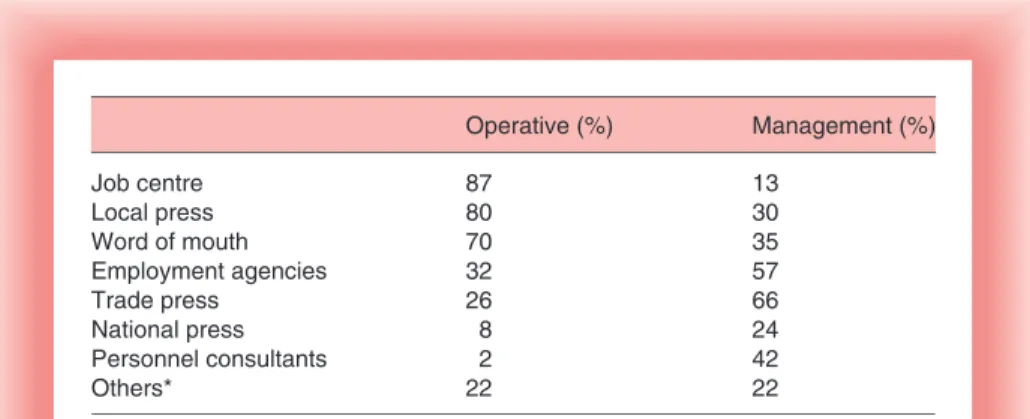
HRM in practice 5.6 ‘Realistic’ recruitment in the cruise industry
For example, if there are too few candidates who are eligible, or if there really are too many candidates. Assuming there are a sufficient number of suitably qualified people for the job, the conventional method is shortlisting compared to a person specification/competency framework. 2005), but note that if a large number of people have applied for a job, there may be fairly arbitrary criteria, such as people being excluded because of their age or writing style.
Selection
However, before going further and examining different selection techniques in detail, it is important to recognize two points that complete the context of the selection process. Often the perception is that the organization has all the power in the selection process.
HRM in practice 5.7 The use of assessment centres by easyJet
One benefit of giving constructive feedback is that at the end of the recruitment and selection process the organization is still maintaining a positive image. Equally, however, we can also say no in terms of the widespread use of traditional forms of recruitment and selection, such as interviewing.
Equal opportunities
Of course, in reality, the approach to equality and diversity adopted by organizations can be well informed by all these aspects. Increasingly, albeit within a more strategic HRM approach, it is suggested that many organizations are recognizing the business case for equality and diversity.
The employment experience of socially defined minority groups
Although women make up 70 per cent of employees, there are no female CEOs in the FTSE 350 travel, leisure and tourism companies (Rossiter, 2005). Similarly, a recent report by Cranfield University found that only 2.3 per cent of board members in the largest companies listed on the London Stock Exchange came from ethnic minority backgrounds (Smith, 2005).
HRM in practice 6.1 Opportunity Now
For example, LRD (2005) notes that 52 percent of workers in Bangladesh work in the restaurant industry, compared to only 1 percent of white males. As we have already noted, the black and ethnic minority communities make up about 8 per cent of the UK's population and will account for significantly half.
A proactive response to gender equality
On the issue of the progression of black and minority ethnic workers into middle and senior management positions a recent report by the Runnymede Trust (2000) found that only 1 per cent of senior managers and 3 per cent of junior managers were from an ethnic minority , despite the fact that ethnic minorities make up 8 percent of the population as a whole. When employing ethnic minority employees, it is notable that they tend to be concentrated in terms of occupational segregation, with a large number employed in the hospitality sub-sector in particular.
HRM in practice 6.2 Perceptions of disability
For older workers, it can be particularly difficult to find a new job, especially if they are over 45 years of age. Work by Qu and Cheng (1996) who surveyed 26 hotels in Hong Kong and Magd (2003) who interviewed 21 managing directors in small and medium-sized hospitality businesses in the UK are useful in understanding how older workers tend to tourism to be observed and hospitality.
The legislative response
Similarly, in the selection procedure, organizations must be careful not to draw up person specifications that are unfairly demanding. Positive discrimination seeks to correct past inequality by giving priority to certain groups in the labor market.
HRM in practice 6.3 Jobs for the girls
Currently, such an approach is illegal in the UK, but such approaches have been used in the US and other countries (and see HRM in Practice 6.3). The DDA is similar to the SDA and the RRA, although it only provides protection against direct discrimination.
HRM in practice 6.4 Conditions amounting to physical or mental impairment
HRM in practice 6.5 An appropriate response to disability?
In such cases less favorable treatment can only be justified if it is relevant to the circumstances of the individual case and if the reason for the treatment is considered serious. More generally, research has highlighted the discrimination faced by gay and lesbian employees.
HRM in practice 6.6 Responding to the needs of visually impaired employees
Create a culture where people can express themselves - most of the above suggest ways in which this can be achieved. If organizations want to avoid such a situation, they need to work towards developing a more proactive approach to the introduction of legislation.
HRM in practice 6.7 British Airways responding to the legislation on religious discrimination
In a more recent review of the new legislation, the Inland Revenue (2006a, b, c) acknowledges that experience in other countries suggests that the introduction of the legislation is likely to result in a large number of age discrimination claims. Surprisingly, CRE will not become part of the new organization immediately, but at the time of writing it is expected to join by 2009.
Managing diversity
In relation to the second question, Table 6.2 shows the way in which different management of diversity and equal opportunities is proposed. In relation to a skilled workforce, Kandola and Fullerton point to the importance of ensuring that the entire workforce is aware of and guides the principles of diversity management.
Training and development
As we are increasingly urged to lifelong learning, training and development for individuals become important. In this chapter we will look at different aspects of these levels, starting by considering the importance of the influence of national government policy on training and development.
Understanding the context: national level responses to training
As a result, training and development activities now emphasize adaptability, flexibility and continuous development to ensure organizations can survive and compete in an increasingly competitive environment. Consequently, there is strong support for the idea that Britain needs to invest in training and development to ensure it doesn't become low-tech.
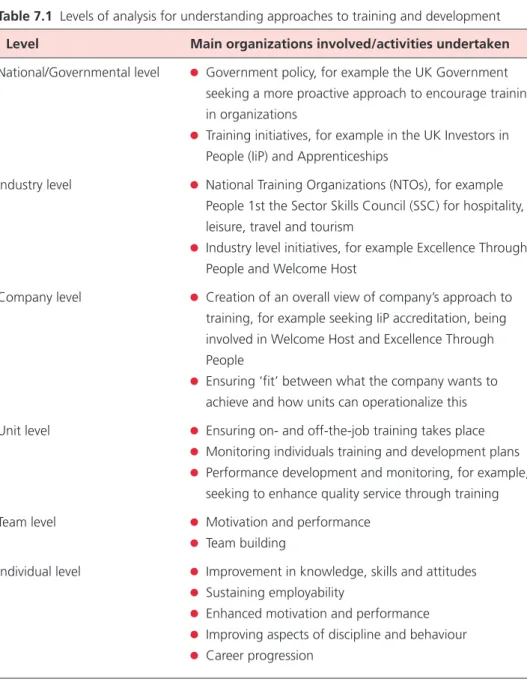
HRM in practice 7.1 National skill-creation systems and career paths in the tourism industry
What this means in practice is that in recent years the UK government has tried to take a more active role by introducing a number of initiatives aimed at improving skill levels in the economy. Indeed, Keep (2005) considers the extent to which the UK may be entering a 'post-voluntarist' era, where government is seemingly increasingly prepared to take a more active role in encouraging learning and development.
N/SVQs
First, their contribution to improving the competitiveness and performance of the UK economy by widening access to training and qualifications. All of the case study organizations were small businesses with between 22 and 44 employees, and four of them had adopted and continued to use N/SVQs, with one adopting and then dropping them.
Investors in people
Despite some criticisms, the IIP appears to have established itself as a positive and important attempt to encourage employers to adopt more systematic approaches to training and development to improve organizational performance and competitiveness. Indeed, it could be argued that the success of a standard can be gauged by recognition on the IiP UK website, http://.
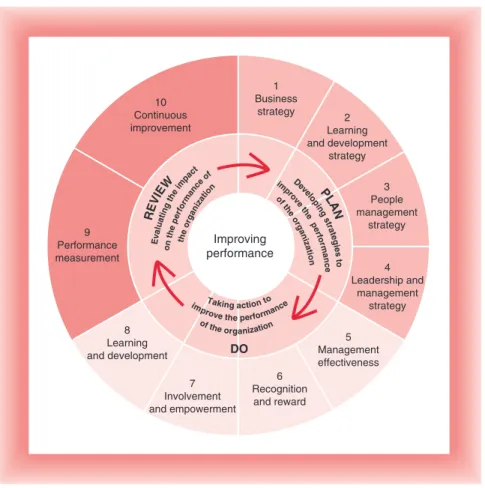
HRM in practice 7.2 Improving training at Pontins
HRM in practice 7.3 Investing in people
Apprenticeships
Industry level
Training and development: no longer a dichotomy?
HRM in practice 7.4 Welcome Host
Professionalizing the tourism industry?
Development, on the other hand, was often seen as a much greater growth or realization of human abilities through conscious or unconscious learning. Training and development can therefore be seen as key instruments in the implementation of HRM practices and policies, so training can bring many benefits.
HRM in practice 7.5 Training and TQM in the restaurant industry in Canada
The operationalization of certain management techniques, such as total quality management (TQM) and empowerment (see HRM in practice 7.5). Nevertheless, there are of course examples of sophisticated and systematic training and development programs in some companies (see HRM in practice 7.6).
HRM in practice 7.6 The training Oscars
For example, Lucas (2004) argues that the industry is still relatively unqualified and that access to training is mostly limited to those in large multi-site organisations. However, there may be an important role for the SSC, People 1st.
Conducting training
- Assessing training needs
- Preparing the training plan
- Specifying the training objectives
- Designing the training programme
- Selecting the instruction methods
The training needs of the individual must also be reconciled with those of the organization. The training plan is concerned with outlining what needs to be done based on the training needs of individuals, departments and the organization as a whole.
HRM in practice 7.7 Heading off the induction crisis
There is a wide variety of other methods that fall under the broad heading of off-the-job training. Think of any on-the-job or off-the-job training you received in the workplace.
HRM in practice 7.8 A flying start
- Completing the training plan
- Conducting the training
- Evaluating the training
- Planning further training
Claydon (eds.) Human Resource Management: A Contemporary Approach, Prentice Hall, 4th ed. Training and development: the employer's responsibility?' in B. For details of the UK training and education framework, visit the QCA website at http://www. qca.org.uk/.
Performance
In examining the nature of performance management and performance appraisal, we must first understand how these two aspects are related, but they should also not be treated as synonymous. In this sense, performance management and performance appraisal can probably be seen to reflect the notions of "hard" and "soft" again to some extent.
The nature of performance management and performance appraisal
Given the above discussion, it seems reasonable to assume that assessment is less likely to be part of a systematic approach to HRM in tourism and hospitality. Interestingly, Lucas also found that performance appraisal is more commonly used in the hospitality industry than in all private sector service organizations.
Appraisal in practice
Similarly, Hoque (1999) found that 89 percent of the 232 hotels he surveyed regularly used appraisal, compared to 62 percent of similarly sized manufacturing establishments. 1998) also found a high incidence of assessment within the US. It is clear then that appraisal is an important part of wider HRM concerns in hospitality and tourism and we can now go on to consider some of the challenges facing managers in operationalizing appraisal schemes.
HRM in practice 8.1 Appraisal: Some good news
In part, some of these negative views of appraisal may be addressed by training managers to ensure they are clear of the importance of appraisal. Insufficient knowledge of the appraiser – so appraiser position is based on position in hierarchy, rather than any actual knowledge of the person's work.
HRM in practice 8.2 Appraisal: Some common negative managerial thoughts
This view points to whether valuations are problematic in themselves or whether much of the problem lies in the performance of the valuation, in particular whether valuations are poorly performed by disinterested or poorly trained managers. Training can then help managers understand the importance of assessment within a broader approach to performance management and also the need to develop coaching skills to enable a more developmental approach.
What can be termed the 'paradox of roles' in terms of the conflation of judge and adviser (mentor), which can lead to confusion. What are some of the skills managers are likely to require to perform a good assessment.
HRM in practice 8.3 The rhetoric and reality of appraisal in ANO Hotels
On the other hand, developmental approaches are likely to have different assumptions, where the assessor and the assessee strive to discuss the progress, hopes and fears of the assessee in a mutually supportive atmosphere and where the ultimate goal is to develop performance through building. employee benefits (and see HRM in practice 8.4). As mentioned above, the nature and focus of assessment has been changing more and more in recent years.
HRM in practice 8.4 Appraisal talking points: Evaluating or developing?
Other methods that organizations can use include performance standards and matching performance with job descriptions, rating an employee based on a scale, for example ranging from 'outstanding' to 'unacceptable' and critical incidents (and see also HRM practice 8.5). HRM in practice 8.5 gives an indication of the type of activities that can be assessed in assessing the performance of managers in the tourism and hospitality industry.
HRM in practice 8.5 The use of BARS in the American hotel industry
Since much of the discussion above has outlined an approach to assessment that is predominantly top-down, there may be Table 8.2 criteria used to measure individual performance. In terms of using customer service data and how it can be used to rate employees, Redman notes how it can be collected in a variety of ways.
Managing poor performance
